Gold Panning in Arizona: Your Complete Guide
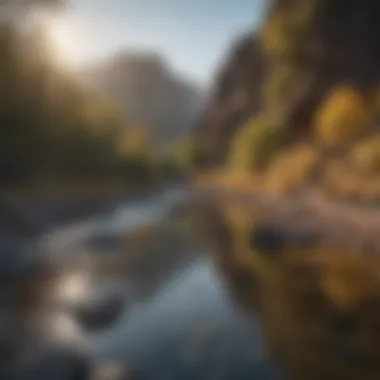

Intro
Gold panning in Arizona isn't just another hobby; it’s a journey back in time where you can attempt to clutch a piece of history in your hands. The allure of gold nuggets glistening in the sun, nestled among the pebbles of a riverbed, calls out to many prospectors, both novice and seasoned alike. Gold has shaped economies, ignited dreams, and even sparked a few heated brawls along the way. It's more than just a shiny metal; it’s a historical artifact, a remnant of an era when dreams of wealth brought settlers to the harsh deserts and mountain passes of the Grand Canyon State.
In this guide, we’ll dig into the roots of gold panning in Arizona, examining its historical significance, the broad geological conditions that contribute to gold’s presence, and effective techniques to increase your chances of success. We will also take a closer look at the regulations that help maintain the delicate balance in local ecosystems, ensuring that the thrill of discovery does not come at the expense of nature itself. With a focus on the meticulous details aimed toward rock and fossil collectors, you will find valuable insights that can elevate your prospecting experience while contributing to responsible collecting practices.
Join the Hunt
Whether you’re planning a weekend outing or dreaming of striking gold, let’s embark on this fascinating exploration together. Grab your pan, let’s feel the rush of the river, and who knows? You might just strike it rich with a nugget as big as your ambitions.
Historical Context of Gold Panning in Arizona
Gold panning in Arizona isn't just a pastime; it's a rich tapestry woven into the very fabric of the state’s history. Understanding this context is vital for anyone serious about the art of prospecting. It serves as a gateway into the adventures and challenges faced by the early prospectors, highlighting their resilience, ingenuity, and the legacies they left behind.
Early Gold Discoveries
The early days of gold discovery in Arizona are often painted with a sense of rugged adventure. Around the 1850s, gold was first reported in the Arizona region, luring fortune seekers from all corners of the United States, and even beyond. Among these early finds, the most notable was the discovery near the confluence of the Hassayampa River and the Plomosa Mountains in 1863, which set off a small gold rush.
It wasn’t just luck that led these prospectors to their fortunes. They relied heavily on local knowledge, sometimes learned through word of mouth from Native American tribes who had lived on the land for centuries. For instance, stories of gold hidden in the valley of Lynx Creek became a siren call for many. The tight-knit nature of these early communities fostered a culture that valued shared experience and expertise in the often-arduous work of panning.
Gold wasn’t only discovered in streams and rivers. The hills and mountains yielded their secrets too. Prospectors scratched at the earth, using simple tools like pans and picks, hoping to find the glint of yellow that would change their lives. Accounts from that time often speak of countless men returning home with little more than tales of hardships, yet some struck it rich – legends like the “Lost Dutchman Mine” still capture imaginations today.
Impact on Arizona’s Development
The gold rush era had profound implications for Arizona's development. As miners flocked to the region, the population began to swell. Towns sprung up almost overnight, with places like Prescott and Tucson transforming from sleepy outposts into bustling hubs. The burgeoning communities were often a melting pot of cultures and traditions, showcasing the eclectic mix of immigrants drawn by a common goal – wealth.
With the influx of people came the need for infrastructure. Roads were built, and rail lines soon followed, facilitating greater mobility for both people and resources. This connectivity opened up trading, commerce, and cultural exchanges, laying the groundwork for what would eventually become a diverse and vibrant state.
The gold rush era was not merely about wealth; it fostered a collective spirit amongst those who sought a better life through their grit and determination.
Employment opportunities flourished, not only for prospectors but also for service providers; merchants, craftsmen, and bar owners found their niche in the growing economy. While some miners struck it rich, most would not see significant rewards, yet their labor paved the way for modern industries, turning Arizona into a cornerstone of the American West.
The influence of gold panning stretches far beyond just the economic outcomes. It shaped the political landscape too, leading to increased interest from federal authorities who recognized Arizona’s potential and sought to impose order in the face of the wild pursuits of gold. This includes the establishment of land policies and regulations that continue to guide prospectors today.
In summary, the historical context surrounding gold panning in Arizona not only underscores the quest for fortune but also serves as a compelling backdrop against which the state's character has developed, informing every panning expedition in its rivers today.
Geological Foundations for Gold in Arizona
Understanding the geological foundations of Arizona is vital when delving into the art of gold panning. The underlying geology of this sun-drenched state has played a pivotal role in creating the conditions necessary for gold deposits. It’s not just about knowing where to pan; it’s about appreciating the surroundings and the geological processes that have shaped them over millions of years.
When prospectors step into the streams and rivers of Arizona, they’re benefiting from an intricate web of geological history. The area has undergone significant geological changes, with ancient volcanic activity, erosion, and sediment deposition all contributing to the formation of gold-laden riverbeds and valleys. This foundational knowledge aids in making informed decisions about where, and when, to pan for gold.
Overview of Arizona’s Geological Makeup
Arizona’s geological tapestry is as diverse as it is rich. At its core, the state is home to several geological formations, mainly featuring igneous, sedimentary, and metamorphic rocks. This mix creates the perfect cocktail for mineralization. For instance, the presence of granite and other igneous rocks often indicates potential sites for gold due to the hydrothermal processes associated with such formations.
- Granite: This rock often hosts this valuable metal as it is a product of cooling magma, which allows for mineral deposits to surface.
- Alluvial Deposits: Streams eroding these rocks can lead to the eventual deposition of gold particles downstream.
- Metamorphic Rock Layers: Areas where these layers have been subjected to pressure and heat can also reveal gold veins.
In addition, the state's unique climate conditions, characterized by dry heat and sporadic rains, mean that erosion can move materials like gold into accessible locations. Overall, grasping how Arizona’s geology is layered provides a strong groundwork for any budding prospector.
Key Regions for Gold Deposits
While gold can essentially be found in various locations across Arizona, several regions have earned reputations as treasure troves for prospective gold miners. Understanding these areas can significantly enhance one’s chances of a successful outing.
- Bradshaw Mountains: Renowned for their historic gold mining operations, these mountains can provide even amateur prospectors a reasonable chance of striking gold. The combination of quartz veins and alluvial plains in this area makes for excellent panning conditions.
- Lynx Creek: Known among panners, Lynx Creek is often hailed as one of the best spots for amateur gold hunting. The creek has been known to yield both fine gold and nuggets.
- Hassayampa River: This river has a storied past, linked to early mining success stories. The river's winding path through mountainous terrains creates a diverse range of opportunities for enthusiasts.
- Castle Creek: While less known than other spots, prospector lore suggests that lucky finds are still waiting to be discovered here, especially in the shallow streambed.
With insights into these areas, a prospector can develop a more focused and purposeful approach to gold panning, turning a simple hobby into a potentially rewarding venture. Each location presents its own unique advantages, and understanding their geological features is key to maximizing success.


Essential Techniques for Gold Panning
The process of gold panning is more than just a simple way to search for shiny flakes in the riverbed; it encompasses a range of techniques that can significantly impact a prospector's success. Understanding these essential techniques is crucial not only for increasing the odds of finding gold but also for enhancing the overall experience of the search. Whether a novice trying out their luck or a seasoned expert looking to refine their skills, mastering these methods can lead to bounteous rewards.
Choosing the Right Location
When it comes to gold panning, location is everything. Selecting the right spot can make or break a day's venture. Ideally, one should seek areas where water flows slowly or where the bed of the river has changed over time, creating natural traps for gold. Some key elements to consider include:
- Historical Significance: Locations near old mining camps or settlements often have higher concentrations of gold due to past excavations and practices.
- Water Flow: Pay attention to the flow of the water; slower currents often mean that heavier materials, like gold, settle there.
- Geographical Features: Look for bends in the river, gravel bars, or the base of cliffs. These features maintain a possibility of catching gold.
By taking time to assess the lay of the land and understanding how the river interacts with the surrounding environment, you'll be more likely to hit the jackpot.
Step-by-Step Panning Method
Once you've chosen a promising location, it's time to get down to the nitty-gritty of gold panning. Here’s a straightforward process you can follow:
- Gather Equipment: Make sure to have your pan, a small shovel, bucket, and a classifier.
- Collect Material: Use the shovel to scoop up gravel and sediment from the riverbed and place it in the pan.
- Add Water: Fill the pan with water, ensuring that the material is covered well. This helps to separate the lighter particles from the heavier ones.
- Wash the Material: Tilt the pan at an angle and gently shake it from side to side, allowing the lighter materials to wash away while retaining the heavier fragments.
- Repeat: Keep adding water and washing until you are left with a concentrate of heavier materials at the bottom of the pan.
- Examine the Residue: Carefully inspect the remaining material for any signs of gold, which appears as small shiny particles.
By following these steps, you can efficiently sift through sediment, increasing your chances of uncovering a golden nugget.
Alternate Techniques: Sluicing and Dredging
While traditional panning gives a hands-on panning experience, there are alternative methods that serious prospectors may employ to maximize their yield:
- Sluicing: This method involves using a sluice box, a channel with riffles designed to catch gold. Water flows through the sluice, allowing lighter material to wash away while heavier gold settles behind the riffles. It's faster and can process more material at once.
- Dredging: For those looking to dig deeper, dredging uses a mechanized system to suck up sediment from the bottom of rivers or lakes. It is effective in reaching gold deposits that traditional methods can't but requires special permits and is heavily regulated.
Both techniques allow for larger quantities of material to be processed, leading to higher efficiency, but they also demand a greater understanding of the local regulations and environmental impacts.
Understanding and utilizing the right techniques can amplify your overall gold panning experience while respecting the natural surroundings.
In sum, mastering these essential techniques can boost any prospector’s chances of striking gold in the heart of Arizona. Whether opting for the classic panning method or exploring alternative avenues like sluicing and dredging, knowing one's way around these practices is key for both successful treasure hunting as well as responsible exploration.
Necessary Gear for Effective Panning
When setting out to pan for gold in Arizona, having the right gear can make all the difference. Not only does essential equipment enhance your efficiency, but it also increases your chances of striking it rich. Think of it like a fisherman without a rod; you might get lucky, but you’re likely to come away empty-handed.
Basic Equipment Required
Before wandering off to your chosen panning spot, ensure you have the fundamental tools in your arsenal. Here’s what you need to start:
- Gold Pan: The heart of your operation. A deep, broad pan facilitates the separation of gold from sediment. Look for a pan with sloped edges to make washing easier.
- Classifier: This tool sieves larger rocks and debris, allowing only finer material to enter your pan. It saves time and helps focus on the more promising sediments.
- Scoop or Trowel: An essential companion for both gathering and transferring material. You’ll want something sturdy but light, preferably with a rounded edge for digging in various terrains.
- Bucket: Keep your pan and other tools organized. A clean bucket can also be used to transport collected materials with ease.
- Snuffer Bottle: This handy tool allows you to suck up small gold nuggets from your pan without the fear of losing them. Think of it as your gold's best friend.
Arming yourself with these basics not only readies you for the task at hand but also sets a solid foundation for more advanced techniques down the line.
Advanced Tools for Serious Prospectors
For those who view panning as a serious pursuit rather than a casual hobby, investing in advanced gear can offer significant advantages. Here’s a look at what seasoned prospectors often carry:
- Sluice Box: This gadget is invaluable for dealing with larger quantities of material efficiently. It allows water to flow through and traps heavier materials like gold. A sluicing setup can tremendously speed up the processing of dirt and gravel.
- Gold Metal Detector: While panning is all about patience, a metal detector can help locate potential rich veins in the ground, saving you lots of time searching.
- Dredge: Combining water and suction, this piece of machinery allows you to access underwater locations that may be tougher to reach manually. As you might guess, it can also boost your gold yield dramatically.
- Campsite Gear: If you plan on spending multiple days out prospecting, having appropriate camping gear—tents, sleeping bags, and cooking utensils—helps create a comfortable base where you can store your finds safely.
- Safety Equipment: Always include a first aid kit, sunscreen, and insect repellent. Being outdoors exposes you to various risks, and it’s best to be prepared.
Having the right gear, whether basic or advanced, doesn't just improve your chances of finding gold. It enhances your overall experience, allowing you to immerse yourself in the beautiful landscapes Arizona has to offer.
"Gold panning is more than just a hunt for treasure; it’s a chance to connect with nature and history.”
So, before you head out, ensure you are well-equipped. Your gear can mean the difference between a fruitful adventure and a disappointing day in the sun.
Understanding Local Regulations and Permits
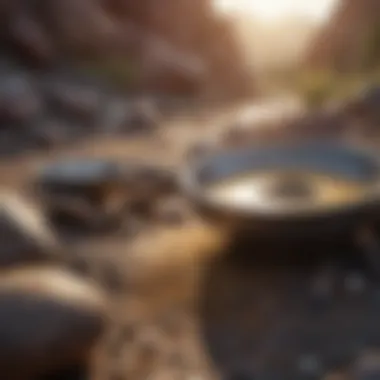
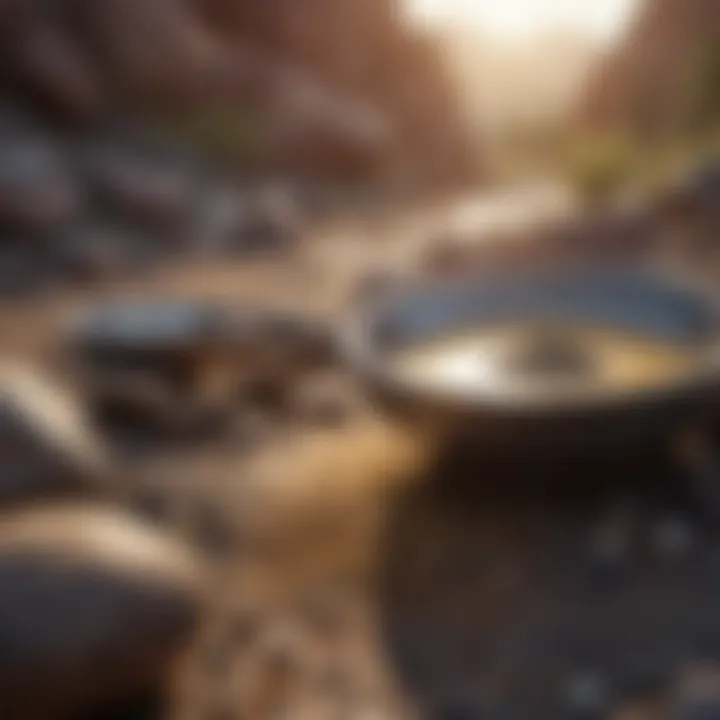
Navigating the world of gold panning in Arizona requires more than just a shovel and a pan. Understanding local regulations and permits is crucial for any serious prospector. Ignoring the rules can lead to hefty fines, and even worse, loss of gear or your prized finds. The regulations ensure that prospectors engage in sustainable practices while also respecting the rights of landowners and the delicate ecosystems that may be affected by mining activities. Here, we’ll delve into the regulatory landscape, highlighting key bodies involved and the permitting processes that every gold panner should be aware of.
Regulatory Bodies and Their Roles
In Arizona, several authorities oversee gold panning activities. The two main players are the Arizona State Land Department and the Bureau of Land Management. The State Land Department governs activities on state trust lands, while the Bureau of Land Management is responsible for federal lands. Both bodies aim to promote responsible use of land while preserving its natural resources for future generations.
Key roles include:
- Issuing permits and managing land use: Each body has the task of providing necessary permits and also making sure lands are treated with respect.
- Monitoring and enforcing regulations: They inspect areas regularly to ensure compliance and can impose penalties for violations.
- Providing educational resources: Websites of these bodies offer guidelines and resources aimed at educating prospectors on best practices and legal obligations.
Permitting Processes for Prospectors
The permitting process can seem daunting, but understanding its structure makes it manageable. First off, it’s important to choose the right area for gold panning. Some regions might not require permits, particularly if you're delving into public lands for recreational purposes. However, if you aim for a more serious venture or are working on state land, permits are a must.
- Identify the Land: Use maps and resources from the Bureau of Land Management to determine land usage rights. Some places are strictly off-limits.
- Apply for the Permit: Each authority has its unique application process. Generally, you’ll need to fill out an application form detailing your intended activities.
- Pay the Fees: Fees vary depending on the type of permit—expect to pay a small fee for permission to pan on state or federal advertised lands.
- Follow Up: After submission, keep communication open with the respective agency to stay updated on approval status.
It’s beneficial to be well aware of special conditions that might apply, such as restricted time frames or designated equipment.
Furthermore, it's worth noting that engaging in illegal panning can not only sour the prospecting experience but also lead to permanent land closures or stricter regulations in the future.
"Regulations serve not only to protect the land but also ensure a fair game for all prospectors involved."
By familiarizing yourself with these regulations and processes, you position yourself as a responsible and informed prospector, capable of enjoying the thrill of the hunt without the cloud of legal complications.
Environmental Considerations in Gold Panning
When you step into the great outdoors for gold panning, it’s more than just hunting for shiny treasures. Recognizing the environmental considerations associated with this activity is crucial for both enthusiasts and the ecosystems that surround them. The pristine rivers and mountains of Arizona attract many prospectors, but how those individuals interact with the land can have long-lasting repercussions for wildlife and natural habitats.
Impact on Ecosystems
Gold panning riverbanks can seem like peaceful havens, but the reality is that these areas are delicate ecosystems. Disruption from panning can lead to soil erosion, which in turn affects local plant life. When dirt is washed away, nutrients can leach into nearby water sources, causing issues like algal blooms that suffocate aquatic life. The sediment can create turbid water conditions, making it tough for fish and other creatures to thrive.
Another major concern revolves around wildlife. Many critters, big and small, rely on these riverbanks for their homes. When humans trample through these spaces, it can scare animals away or even lead to habitat destruction. For instance, birds may abandon their nests or young due to human noise and movement. 🦅 Understanding this impact is the first step toward responsible panning.
"Being mindful of our activities ensures that nature can continue to flourish, making gold panning a sustainable hobby."
Best Practices for Responsible Panning
Embracing best practices in gold panning doesn’t just protect the environment; it also elevates the quality of the experience for everyone involved. Below are some simple yet effective guidelines that every enthusiast should adopt:
- Choose the Right Spot: Always select areas that have been explicitly designated for panning. Many popular sites are managed to balance recreation with environmental health.
- Minimize Disturbance: Be aware of your surroundings as you engage in panning. Avoid trampling over areas that seem particularly pristine or sensitive.
- Use Lightweight Equipment: Heavy gear can compact soil and disturb natural habitats. Opt for lighter tools that won't cause excessive disruption.
- Pack Out What You Pack In: Adhering to the "Leave No Trace" principle is fundamental. Bring trash bags to collect anything you might leave behind, from food wrappers to broken gear.
- Follow Local Regulations: Different areas have specific rules to protect their ecosystems. Educating yourself about these regulations is key to preventing adverse effects on wildlife and habitats.
By adhering to these practices, those seeking their fortunes in the waters of Arizona can minimize their environmental footprint. Gold panning can coexist with a thriving ecosystem—achieving harmony between human activity and nature is vital.
Notable Gold Panning Locations in Arizona
Arizona's landscape is dotted with venues that resonate with the rich history of gold panning. Knowing where to pan is fundamental to any prospecting endeavor. These notable locations not only offer potential rewards but also serve as invaluable experiences that connect individuals with nature and history. Understanding these areas’ unique characteristics and what they have to offer—whether it’s the geological formations or historical significance—can enhance any enthusiast's adventure.
The Famous Bradshaw Mountains
The Bradshaw Mountains are often heralded as one of the premier gold panning spots in Arizona. Situated just north of Phoenix, this mountainous terrain is not just visually striking but also rich in mineral deposits. Gold was first discovered here in the late 1800s, making it a hotbed for prospectors aiming to strike it rich.
A few key points make this location particularly interesting:
- Historical Significance: The mountains were the site of the famous Crown King Gold Mine. The area thrived in the late 19th century, drawing many hopeful miners.
- Diverse Ecosystem: Besides the potential for gold, the Bradshaw Mountains are home to various flora and fauna, making any trip ripe for exploration.
- Seasonal Access: Be aware that accessibility can be impacted by weather. Winter snow can render certain trails impassable.
The experience here is a blend of past and present, where modern-day prospectors can tread trails once walked by pioneers.
Exploring the Hassayampa River
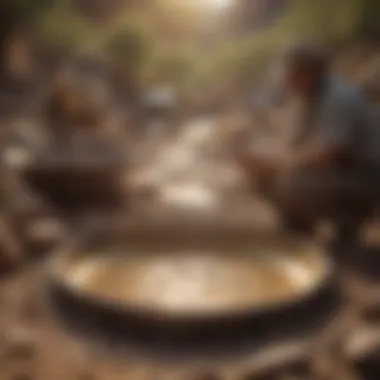
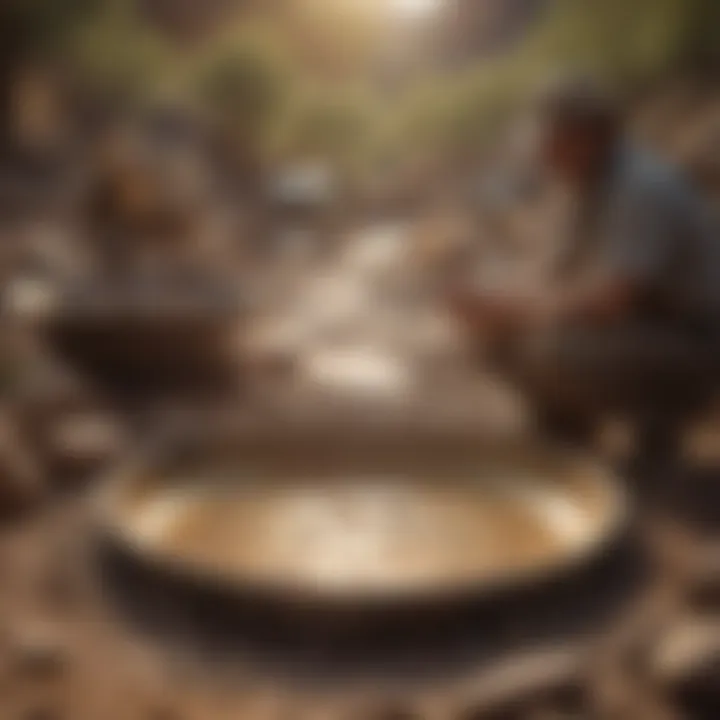
The Hassayampa River offers a tranquil yet promising spot for gold panning enthusiasts. Flowing through the lush landscapes of central Arizona, this river is less crowded than some of the more popular locations, allowing for a peaceful day by the waterside.
Some elements to consider when exploring the Hassayampa include:
- Rich Alluvial Deposits: The river’s banks often reveal substantial deposits where gold can be found. The movement of water has naturally sorted materials, making it easier to spot potential nuggets.
- Wildlife Observation: The serenity of the river also invites a variety of wildlife, providing an opportunity for bird-watching when the gold panning slows down.
- Accessible Sites: Different parks along the river offer public access points with ample space to set up for panning.
The Hassayampa provides both a remarkable backdrop and the chance to take home a souvenir of your own.
The Riches of Lynx Creek
When it comes to gold panning, Lynx Creek is nothing short of a gold mine—sometimes literally. This creek has a storied past, having been a significant site during the gold rush of the 19th century. Today, it is an accessible location that continues to attract prospectors of all experience levels.
Various factors contribute to Lynx Creek's reputation:
- Established Campsites: There are areas specifically designated for gold panning, making it easy for beginners to get started. Established sites provide basic amenities that can enhance the experience.
- Community Engagement: The creek is a popular gathering place for local prospectors, often resulting in a communal vibe where tips and tricks can be shared.
- Potential for Findings: Many reports indicate successful gold finds here, with both small specks and larger nuggets being uncovered regularly.
Lynx Creek not only enriches its visitors but also fosters a sense of camaraderie among those drawn to the lure of gold.
Techniques for Maximizing Gold Recovery
Gold panning in Arizona is not just a recreational activity; it’s an art that demands an understanding of specific techniques to maximize your chances of finding that elusive shiny nugget. Ensuring that every dip of the pan brings you closer to success involves comprehending some essential elements that make gold recovery more efficient and rewarding.
Understanding Gold’s Density
Gold is unique in its properties, particularly its density. It is about 19.3 times denser than water, which is crucial when prospecting. This density plays a significant role in the gold panning process. When you are sifting through materials in your pan, lighter particles, such as sand and gravel, will wash away more easily, leaving behind the heavier gold particles behind.
To leverage this property, it's imperative to understand the right techniques:
- Layering: When you fill the pan, ensure that you have a good mix of materials. The heavier materials should settle at the bottom. When panning, gently shake the pan from side to side to help gold settle lower.
- Water Use: Using clear water can help you see the lighter materials washed away, making it easier to observe any gold nuggets or flakes that remain.
This technique has a simple but profound implication: by managing your panning actions with an understanding of density, the odds of recovering more gold significantly increase.
Utilizing Water Currents to Your Advantage
Water currents are nature's friend when it comes to panning for gold. Knowing how to harness them can lead to better results. The flow of water can move lighter materials swiftly while allowing denser gold to settle into the crevices of your pan. Thus, working with the current rather than against it is key.
Here are some strategies to consider:
- Positioning Your Pan: When you're in a river, face upstream. This positioning allows the light materials to wash away more effectively.
- Following the Flow: Find spots where the water current slows down, like behind rocks or in small eddies. These are prime areas for gold accumulation as the current's speed decreases, allowing gold to settle.
- V-Shaped Panning: Holding your pan at an angle can help catch any gold particles when you’re using flowing water. The bottom's slant helps keep the denser materials in the pan while allowing lighter materials to make their way out.
Successful gold panning isn’t about luck; it’s about using the tools of nature to your advantage. Through density and current awareness, you can significantly increase your yield.
By putting these techniques for understanding gold density and utilizing water currents into practice, prospectors can turn a fun day of panning into a successful quest for nuggets. The marriage of knowledge and practice forms the backbone of any successful gold recovery endeavor.
Safety Measures and Precautions
When it comes to gold panning in Arizona, safety is not just a recommendation; it’s a necessity. The thrill of finding a shiny nugget can sometimes overshadow the risks that come with this adventure. Understanding and implementing safety measures can make the difference between a memorable day in the great outdoors and a trip full of unforeseen mishaps.
Awareness of Wildlife
Arizona is home to a diverse range of wildlife that calls the desert and mountain regions home. From the majestic bobcat to the elusive rattlesnake, the flora and fauna are stunning yet can present dangers if one isn't cautious.
While out panning, keep an eye on your surroundings. If you’re by a river or creek, it’s not just the gold in the water to watch for. Snakes may be sunbathing nearby, while larger mammals like javelinas could wander into your vicinity, especially if food is left unattended.
- Keep your distance: If you spot wildlife, maintain a respectable distance. Observing them from afar minimizes the chances of a sudden confrontation.
- Store food properly: Remember to securely store snacks and trash in containers that animals can’t access, ensuring you don’t attract wildlife.
- Stay alert: When hiking to your chosen site, be mindful of your steps. A careless misstep could mean a nasty encounter.
Avoiding Hazardous Areas
The thrill of the chase is sometimes found in the most remote spots, but not every nook and cranny is safe for prospecting. Certain areas may pose significant risks due to unstable ground, swift water currents, or steep drop-offs. Here are some pointers to keep in mind:
- Research your area: Before you even pack your gear, familiarize yourself with the location. Check online forums like Reddit or articles on Wikipedia for experiences from other prospectors.
- Check weather conditions: Water levels can rise unexpectedly, turning a calm stream into a rushing torrent. Make sure to check forecasts before heading out, especially during monsoon season.
- Wear appropriate gear: Proper footwear with good traction can prevent slips and falls. Likewise, a sturdy hat can protect from overhead hazards and sun exposure. Always consider a basic first aid kit as part of your gear.
"Safety is not an option; it's a priority that paves the way for a successful gold panning adventure."
By being mindful of the unique risks in Arizona's wilderness, you bring confidence and enjoyment to your panning experience. Keeping both yourself and the environment safe should always be at the forefront while you pursue this fascinating passion.



